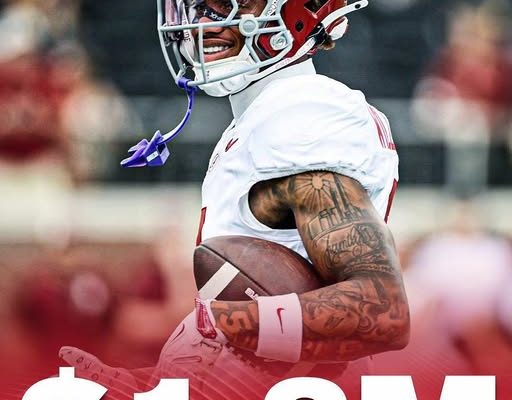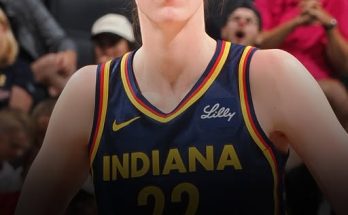Alabama football has always been at the center of national conversations, whether because of national championship runs, NFL pipeline success, or the sheer star power the program consistently produces. In 2025, one of the biggest stories revolves around wide receiver Ryan Williams, a player whose talent, charisma, and potential are impossible to ignore. Williams is not just a dynamic playmaker for the Crimson Tide, but also a lightning rod for discussions about the new era of college athletics, where NIL money, media presence, and performance on the field all converge to shape the trajectory of a player’s career. According to On3, Williams is set to make north of $1.8 million this season, which places him as the second-highest earning wide receiver in all of college football. That figure alone sparks conversations about the value of elite wide receivers in today’s game, but Williams’ recent comments about Ohio State’s Jeremiah Smith take things to another level, and fans everywhere are paying attention.
When Williams sat down with On3 and admitted, “Jeremiah Smith had the better season last year … this time around, I hope I can flex,” he showed an honesty and competitive edge that separates him from the typical hype-driven responses you often hear in interviews. For a player with his résumé and financial standing, it would be easy to sit back and bask in the attention, but Williams is choosing a different path. He recognizes that Smith, the Ohio State phenom who was one of the most impactful true freshmen in recent memory, outperformed him in 2024. That acknowledgment sets up a fascinating storyline for the 2025 season, because while Williams is already a household name in Tuscaloosa and beyond, he has openly declared his intention to raise the bar. In an era where college athletes are compensated at levels once reserved for professional players, Williams’ words carry weight. His $1.8 million figure not only validates his marketability and skillset but also raises expectations for what he must do on the field.
The financial piece cannot be overlooked here. NIL has completely changed the landscape of college sports, and Williams is one of the poster children for this transformation. Alabama fans have always been passionate and supportive of their stars, but when a player becomes a multi-million-dollar figure while still in college, it intensifies the scrutiny. Every drop, every route, every highlight catch becomes magnified, not just by fans but by critics who want to see if the money matches the production. Williams seems to embrace that pressure. He doesn’t shy away from comparisons, and by putting Jeremiah Smith’s name in the conversation, he is setting himself up for one of the most intriguing positional rivalries in all of college football.
Jeremiah Smith, after all, is no ordinary comparison point. He was the centerpiece of Ohio State’s wide receiver corps last year, showcasing a mix of size, speed, and polish rarely seen in a freshman. The Buckeyes leaned on him heavily, and he delivered with big-time performances in some of the biggest moments. Williams acknowledging that Smith had the better season doesn’t diminish his own accomplishments, but instead positions him as someone hungry to prove he belongs in the conversation for best receiver in the nation. Fans of Alabama will see this as fuel for an already talented offense, and neutral fans will view it as the beginning of a potential rivalry that could extend well beyond college, perhaps even into the NFL if both players continue on their current trajectory.
From Alabama’s perspective, Ryan Williams’ growth and leadership matter just as much as his stats. The Crimson Tide are in the middle of a new chapter under Kalen DeBoer, who took over the program after Nick Saban’s retirement. In this transitional period, having a face of the program like Williams helps stabilize the national perception of Alabama. He is not just another five-star recruit who faded into the system; he’s a star who embraces the spotlight and delivers on it. When fans hear that he is earning $1.8 million this season, the natural reaction is a mixture of pride and pressure—pride because Alabama continues to attract elite talent, and pressure because financial figures this large bring with them the expectation of elite performance every single Saturday.
Williams’ situation is also part of a broader cultural conversation. College football has always been about rivalries, not just between teams but between players. From Tim Tebow versus Colt McCoy to Julio Jones versus A.J. Green, fans love debating who is better and why. In the NIL era, these debates are amplified by financial numbers, social media clout, and national exposure. Williams’ comments about Jeremiah Smith are not just about football; they are about brand positioning. By inserting himself into that rivalry publicly, Williams is guaranteeing that eyes will be on both him and Smith every week this fall. Analysts, fans, and even casual observers will track their stats side by side, debating who deserves the “best WR in CFB” crown. This kind of storyline drives engagement, and Williams knows it.
From a purely football standpoint, there is every reason to believe Williams can take the next step this season. His route running has improved, his chemistry with Alabama’s quarterbacks continues to build, and his explosiveness makes him a threat every time he touches the ball. Opposing defenses already game-plan specifically to contain him, but his ability to break through double coverage and still make plays is what makes him such a rare commodity. With DeBoer’s offensive system emphasizing tempo, spacing, and creativity, Williams should have ample opportunities to “flex” the way he hopes to. If Alabama’s offensive line holds up and the quarterback play remains steady, Williams could easily find himself not just matching Smith’s production but surpassing it.
But football is never just about individual performance. Context matters, and that’s where things get even more interesting. Ohio State’s offensive philosophy and quarterback play are often tailored to maximize wide receiver output, and Jeremiah Smith benefited greatly from that system. Alabama, under DeBoer, will be adjusting its identity. That means Williams’ numbers might not always line up perfectly with Smith’s, but his impact on games could be just as profound. Fans and analysts will need to decide how to weigh raw stats against overall contribution, and those debates will rage all season long.
The beauty of Williams’ comment is that it has sparked this very conversation months before the first game is even played. College football thrives on narratives, and “Ryan Williams vs. Jeremiah Smith” might be the biggest individual storyline of 2025. Both players are young, both are already millionaires thanks to NIL, and both have the skillsets to dominate at the next level. Every catch, every touchdown, and every big game will be compared side by side, and fans will inevitably pick sides. Alabama fans will flood social media with highlight clips of Williams’ acrobatic catches, while Ohio State fans will tout Smith’s dominance and reliability. Neutral fans will watch the spectacle unfold, enjoying the friendly rivalry between two of the sport’s brightest young stars.
At the same time, Williams’ situation opens up broader debates about the impact of NIL on college sports. Is $1.8 million too much pressure for a player still in his teens? Does the money distract from the purity of the game, or does it simply reflect the value these athletes bring to their universities and brands? Williams, whether he realizes it or not, is at the forefront of this discussion. His success—or struggles—will become a case study in how young athletes navigate wealth, fame, and expectation all at once. Fans will weigh in not just on his catches and touchdowns, but on his maturity, his interviews, and his ability to handle the spotlight.
This is why engagement on stories like this matters. Fans have strong opinions, and Williams’ situation invites conversation from every angle—football performance, NIL money, player rivalries, and the evolution of college sports. Do you think Williams deserves his $1.8 million valuation? Do you believe Jeremiah Smith is the better receiver right now, or do you think Williams’ hunger and Alabama’s system will push him past Smith this season? Does the comparison even matter, or is it unfair to weigh players against each other when their systems and circumstances are so different?
The truth is, these discussions are what make college football so compelling. Beyond the scores and standings, it is the narratives, rivalries, and personalities that bring fans together and keep them invested year after year. Ryan Williams has embraced that reality, and by making his bold statement, he has ensured that Alabama fans, Ohio State fans, and neutral observers will be locked into his every move this season. Whether you agree with him or not, his willingness to acknowledge Jeremiah Smith’s success and frame his own season as a response shows a competitive fire that makes him easy to root for.
So as the season approaches, the spotlight will only get brighter. Ryan Williams has the money, the platform, and the opportunity to cement himself as the best wide receiver in college football. Whether he delivers on that promise will be the subject of endless debate, and that is where you come in. This is your chance to weigh in, to share your perspective, and to be part of the conversation as it unfolds. Do you think Ryan Williams is ready to flex and prove himself as the number one wide receiver in the country? Or do you think Jeremiah Smith will keep the upper hand in this budding rivalry? Share your thoughts, opinions, and predictions below—because this storyline is only just getting started, and your voice makes it even more exciting to follow.



